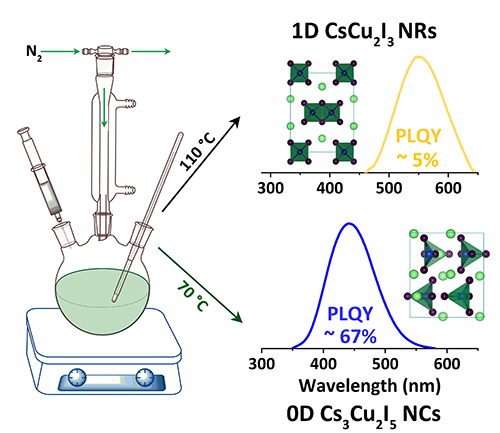A research group led by Prof. HAN Keli from the Dalian Institute of Chemical Physics (DICP) of the Chinese Academy of Sciences (CAS) revealed the dynamic mechanism of all-Inorganic low-dimensional cesium copper halide nanocrystals. This work was published in Angew. Chem. Int. Ed..
Organic-inorganic metal halide semiconductors have shown promising prospect in a variety of optoelectronic applications due to their excellent optical and electronic properties. The exceptional structural tunability of such materials enables them to form various types of crystal structures, from three-dimensional (3D) networks to two-dimensional (2D) layers, one-dimensional (1D) chains and ultimately zero-dimensional (0D) isolated structures at the molecular level.
Although significant progress has been realized in the study of 3D and 2D metal halides, 1D and 0D metal halides, which exhibit unique photophysical properties due to the strong quantum confinement effects, have not been fully investigated to date.

Colloidal synthesis of cesium copper halide nanocrystals.
The scientists reported the colloidal synthesis of all-inorganic low-dimensional cesium copper halide nanocrystals (NCs) by adopting a hot-injection approach. Using the same reactants and ligands, but at different reaction temperatures, both 1D CsCu2I3 nanorods (NRs) and 0D Cs3Cu2I5 NCs could be prepared.
The as-prepared 1D CsCu2I3 NRs showed a weak yellow emission with a PLQY of 5%, while 0D Cs3Cu2I5 NCs exhibited a bright blue emission with a PLQY up to 67%. From 1D CsCu2I3 to 0D Cs3Cu2I5 , the reduced dimensionality made the excitons more localized as indicated by density functional theory, which accounted for the strong emission of 0D Cs3Cu2I5 NCs.
Subsequent optical characterization revealed that the highly luminescent, strongly Stokes-shifted broadband emission of 0D Cs3Cu2I5 NCs arose from the self-trapped excitons (STEs).
Their findings not only present a method to control the synthesis of low-dimensional cesium copper halide nanocrystals but also highlight the potential of 0D Cs3Cu2I5 NCs in optoelectronics.
This work was supported by the key research project of National Natural Science Foundation. It was dedicated to the 70th anniversary of DICP. (Text and Image by Cheng Pengfei)